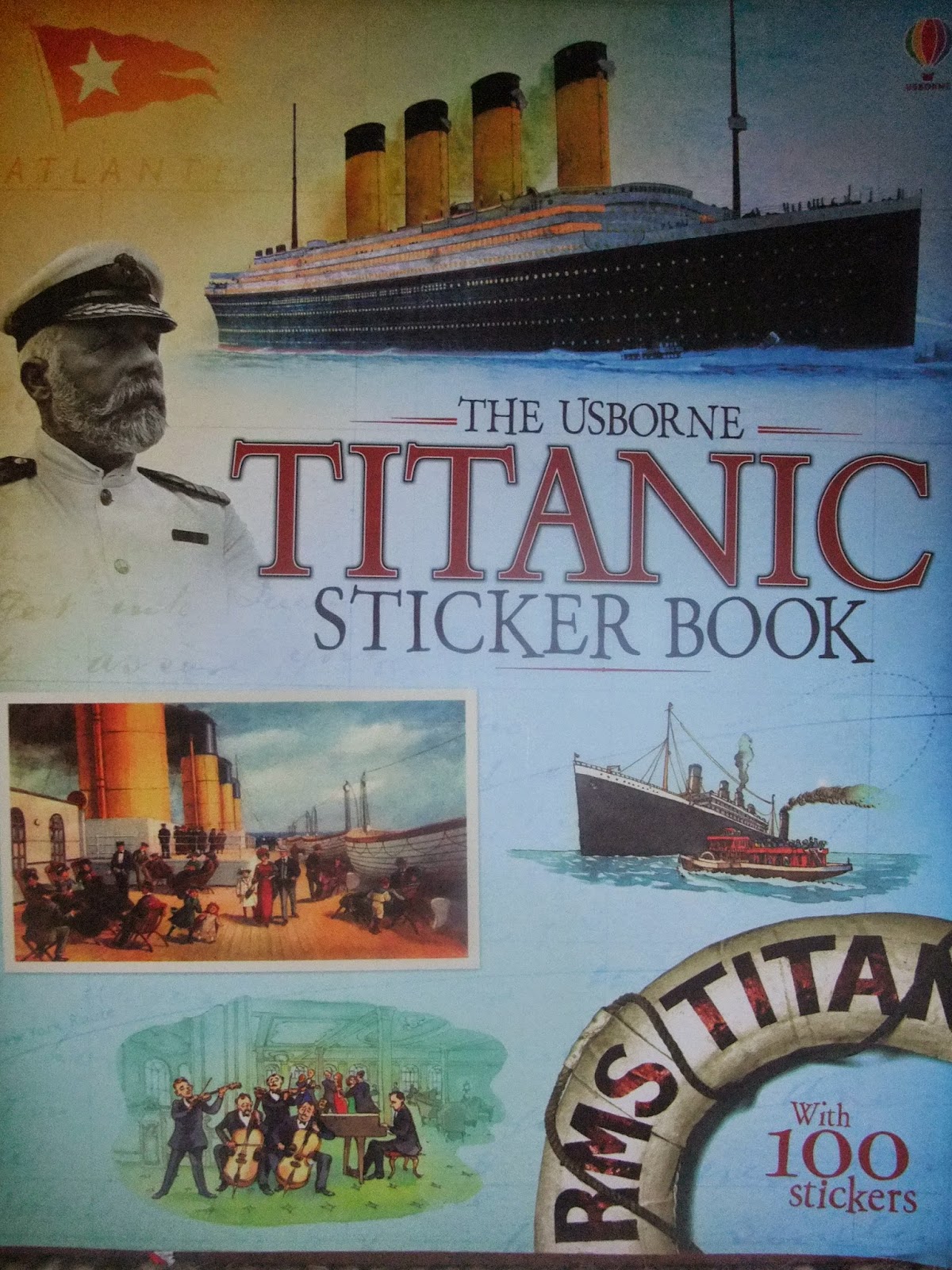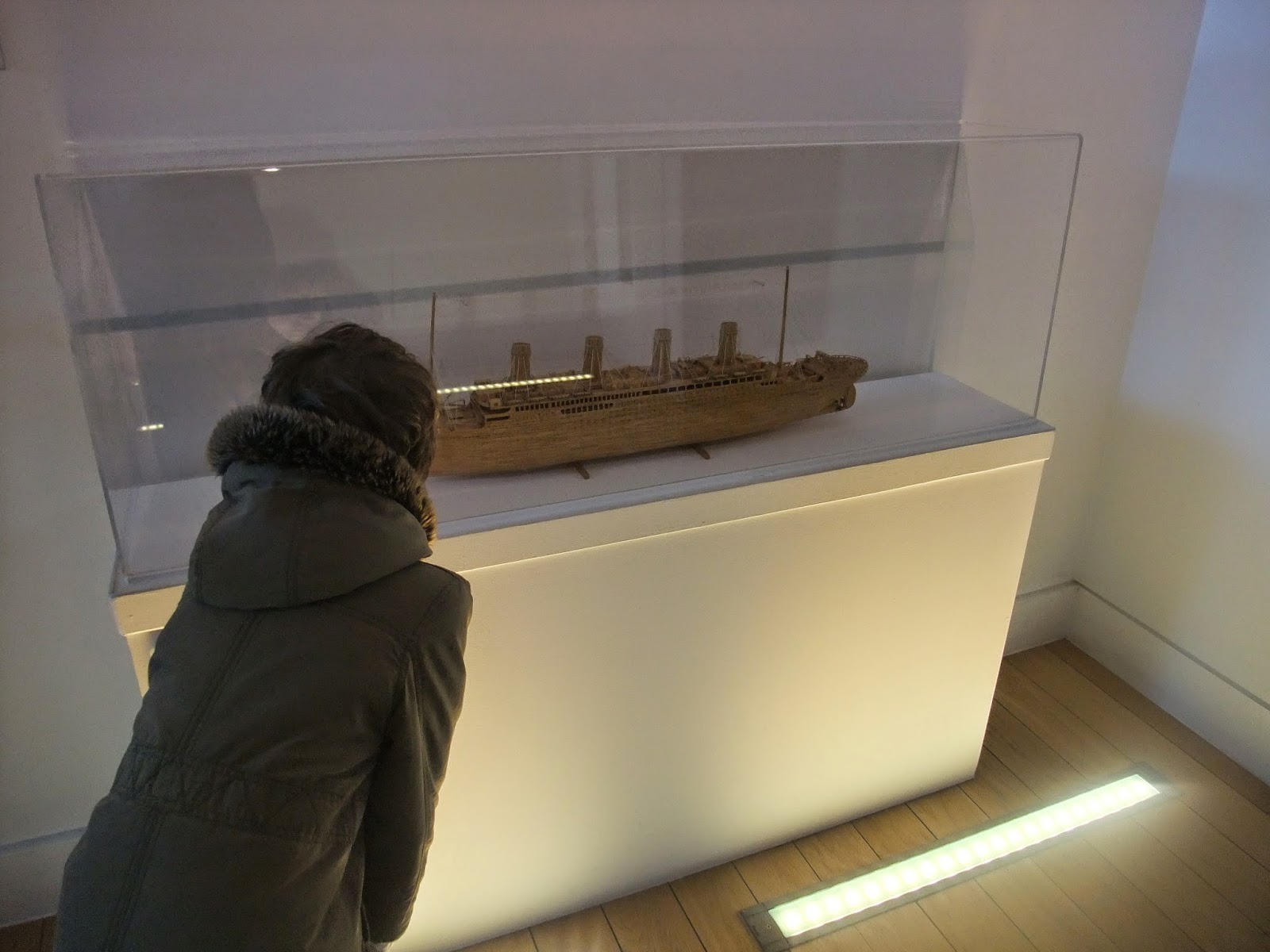On Thursday, we spent a large part of our day on trains, but it was worth it because they took us to an excellent exhibition: the Titanic Exhibition at the SeaCity Museum in Southampton.
Over 500 households in Southampton lost a family member on the Titanic. Following the coal strike of early 1912, many people were out of work and there were 17,000 unemployed in the city, so many jumped at the chance of work on board. Many of them had never been to sea before.
During the long train journey, Charlie spent some time reading his new Usborne Titanic Sticker Book, which I had bought as a surprise present for the trip.
Although it would be fair to say he spent more time designing his recreation of the Titanic on the Minecraft app.
 |
| The watertight compartments |
 | |||
| The boiler room |
We arrived at around 11.30am, which gave us three hours to spend on the exhibition before we needed to catch the train home in order to avoid the rush hour.
 |
| View of the SeaCity Museum with the Clock Tower under scaffolding |
After we'd paid, we were given a copy of the museum trail for Charlie to fill in as we walked round. He's not usually too keen on these, but this was just the right length: brief enough not to take up too much time.
The first room we entered featured several models of the Titanic. Charlie was particularly impressed by one made entirely out of matches by a local model maker, David Reynolds. It had taken Reynolds 300 hours to build.
A second model, made by Charles Lane, featured a notice which set the scene by explaining that the Titanic and Olympic were designed to be the biggest and most luxurious of all the ocean liners offering a Southampton - New York service.
Rounding a corner, we were confronted by this striking display:
More than three quarters of Titanic's 897 crew members lived in Southampton in the days before the ship set sail. Some lived in the town, others stayed there before taking up their post on board.
Three crew members, in particular, are a focus of the exhibition: Captain Edward John Smith; Second Officer Charles Herbert Lightoller; Walter Francis Fredericks (coal trimmer); Mabel Bennett (stewardess); Sidney Sedunary (Deputy Chief Steward); and Archie Jewell (lookout).
Walking past the photographs, we were transported into a street in 1912, complete with the sounds of the city. Old films and display cases featuring artefacts of the time added to the atmosphere.
The words and pictures tied in neatly with our discussion about the class differences of the time.
We discovered a wardrobe full of children's dressing-up clothes, but Charlie was reluctant to try them on. My enthusiasm at photographing him all dressed up probably didn't help. He couldn't resist trying on a life jacket though, so I got my photo in the end.
There was a lot to see in the next part of the exhibition, which was very skillfully laid out and with plenty to keep children and adults entertained.
 |
| Lots of touchscreens |
 |
| The White Star Line flag |
 |
| A number of artefacts |
 |
| Original film footage from the time |
 | ||||
| Paintings, such as this one by George Fraser, painted in 1912 |
A particularly striking display was of the Olympic's grand staircase with carved wooden panel, similar to the one on Titanic.
Then the boilers needed stoking...
And, finally, there was a reproduction of the Marconi room, featuring interactive panels cleverly disguised as papers on a desk. It should have been possible for Charlie to have a go at sending Morse code, but the headphones were missing, so he had to give that a miss.
We were also able to look inside a replica of a second-class cabin, which gave us a real sense of looking into the ship itself.
We were thoroughly enjoying ourselves, but the next room brought us up short: the Disaster Room. I had been forewarned about this because it was mentioned in the children's trail, so I asked Charlie if he wanted to stay and listen to survivors talking about the disaster or to move on. He was in no doubt that he wanted to skip this bit, so we moved straight on to the next room. This had a sombre feel, as it was all about the aftermath of the disaster. At least it included lots of survivors' stories and pictures, which brought some comfort.
The final room covered the inquiry and Charlie wasn't interested in this at all, so I suggested a quick visit to the gift shop, followed by lunch, to which he readily agreed.
After a sandwich and drink, we decided to have a brief look at the rest of the museum before starting our journey home. Charlie was distracted by this machine, artfully placed in the foyer, and I let him choose a penny to stamp.
He chose the Titanic stamp, of course.
We both wanted to see the large-scale model of a liner that I had seen online, whilst reading about the exhibition. It turned out to be a model of the Queen Mary. Charlie was impressed by the size of it.
During our brief exploration of the museum's other main permanent exhibition, 'Southampton: Gateway to the World', we found out about the emigrants who have passed through Southampton on their way to a new life or seeking a new life in our country. This supported our earlier discussion about emigration. I even found an exhibit similar to the 'What would you pack in your suitcase?' worksheet Charlie had filled in at home.
 |
| Charlie chose a jar of Marmite, a shirt and a teddy |
By now, it was time to go home. Somehow, the journey home felt even longer than the journey out, but we passed the time playing games, reading and dozing.
I was pleased that Charlie had mostly completed the museum trail, so we had something to put in his Titanic project book, alongside our photos. He doesn't much like writing, so I wrote his answers for him for a couple of questions.
Once home, Charlie presented his Dad with a bottle of Titanic Iceberg beer from the museum gift shop, a present that was gratefully received.
We had a great day out and I would thoroughly recommend the exhibition to anyone interested in the history of the Titanic.



























Wow, what a fantastic exhibition! I don't know whether we will get to see it in person but I've really enjoyed following your trail around the museum in this post. Thanks for sharing about your trip!
ReplyDeleteGlad you enjoyed it, Hwee. Thanks for reading.
ReplyDeleteI throughly enjoyed reading this post and I almost feel as though I have been there myself now:) the museum looks very interesting and I can imagine my boys steering the ship for a long time.
ReplyDeleteThanks so much for linking this up to the homeedlinkup:)
So pleased you liked this, Pru. It was a great day out.
ReplyDelete